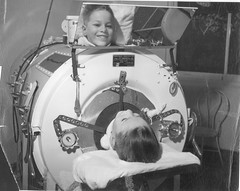Yellow Fever and Walter Reed
Yellow fever is caused by a virus transmitted by a mosquito. This disease has menaced communities since before the founding of the United States. Yellow fever was first described by Joam Ferreyra Da Rosa in 1694. The origin of the term "yellow fever", however, is obscure. Some feel the name reflects the symptoms since the virus destroys liver cells and causes jaundice which is a yellowing of the skin and eyes. Others feel that the name refers to the yellow quarantine flag flown by ships carrying the disease, especially since the fever apparently travelled from Africa on slave ships which were notorious carriers of the fever.
Yellow fever has a wide variety of symptoms including headaches, backaches, nausea and fever. The most disturbing symptom is bloody vomiting which gave the disease the vivid name of "the black vomit". The disease has a fatality rate between 10 and 15% but is less virulent in children. Currently, the disease is incurable and attentive nursing and rest are the only treatments.
Walter Reed was born in Virginia in 1851. In 1869, Reed graduated from the University of Virginia with a degree in medicine and studied at Bellevue Medical Hospital in New York. He joined the Army Medical Corps in 1875 and spent most of the next two decades at frontier posts. In 1893, Reed began serving as curator of the Army Medical Museum and professor of bacteriology and clinical microscopy at the Army Medical School. As part of the Surgeon General's Office staff in Washington, Reed was assigned to investigate typhoid fever in 1898 and then yellow fever a year later.
Reed was the first man to prove the mechanics of infection of yellow fever. Prior to his work, several novel ideas had been considered.
For instance, Benjamin Rush, the noted Philadelphia physician, believed the disease was caused by rotten coffee. Others held that "miasmas" or bad airs were the cause. However, throughout the century, glimpses of the true means of transmission had been noted. In 188 Dr. Josiah C. Nott of Alabama suggested that mosquitoes might be the vector or carrier of the disease. Carlos Juan Finlay of Cuba strongly advanced this idea although current theory held that "fomites" or household articles were somehow infected with the disease.
In 1899 during the wake of the Spanish-American War, Reed headed a team investigating the cause of yellow fever. The team, composed of Dr. James Carroll (also of the Army Medical Museum), Dr. Aristides Agramonte and Dr. Jesse Lazear, convened at Columbia Barracks near Havana, Cuba. Their first accomplishment was to quickly rule out a recently-proposed bacterial theory. Then, using volunteers, the team tested the fomite theory with articles fouled with the effusions from yellow fever victims. This theory, too, was proven wrong. After a prison outbreak when one prisoner was infected and died but the eight other prisoners were not infected, researchers could not suggest a method of transmission other than mosquitoes. Finlay had provided mosquitoes for testing and Dr. Lazear began experiments with them. By having a mosquito bite them, Lazear successfully infected Dr. Carroll and a volunteer soldier named Dean in August. Lazear may have been testing his theory on himself for he was infected and died on September 25, 1900. Lazear's notebooks enabled Reed to study the data Lazear compiled. Reed realized that the Aedes aegypti mosquito carried yellow fever but only under certain conditions. The mosquito must bite a yellow fever victim during the first three days of an attack, incubate the virus in its body for at least twelve days and then bite another person to pass on the disease. This discovery enabled the United States to essentially eradicate yellow fever within its borders after one last epidemic in New Orleans in 1905. The disease proved easy to conquer because the Aedes aegypti mosquito is an urban mosquito and breeds only in small pools of stagnant water such as fish ponds or even flower jars. Yellow fever is still prevalent in tropical climes due to both a different mosquito vector, the Haemagogus spegazzinii and the fact that jungle yellow fever, as it is occasionally known, can live in monkeys as well as human hosts.
Object List:
Two Reed medals (M-900 00682, ASTM medal; M-900 00683, Congressional medal) Text: Medals awarded to Walter Reed for his work on yellow fever by Congress and the American Society of Tropical Medicine. M-900 00683; M-900 00682.

Photo of Reed at 25 (NCP 876 Text: Reed at age 25. NCP #876

Sontag volunteers photo. Text: Soldiers who volunteered for yellow fever experiments. Sontag Collection.
Reed microscope (M-030 00420) Text: Microscope used by Reed. M-030 00420.
Mosquito drawing








